Part 4: Maintaining and renewing public assets
4.1
In this Part, we summarise the information we collected about:
- whether public entities have plans for maintaining and renewing their assets;
- how well those plans are followed; and
- whether public entities know the extent of deferred maintenance and renewals.
4.2
Managing public assets for their full life cycle requires well-integrated planning, good underlying data about assets and the services that they provide or support, and good systems. The condition of assets must be managed effectively for the assets to continue delivering services. Long-term deferring of asset maintenance and renewals can lead to more breakdowns and service disruption, substandard services, and, in the end, failure of services.
Entities' plans for maintaining and renewing assets
4.3
The information we collected shows that entities have documented maintenance and renewal profiles in place for 75% of assets. Educational assets,9 social, cultural, and heritage assets, and environmental assets were least likely to have a plan in place.10
4.4
Figure 6 shows, for each group of assets, the percentage of assets with plans in place for maintenance and renewal.
Figure 6
Maintenance and renewal profiles, by service group
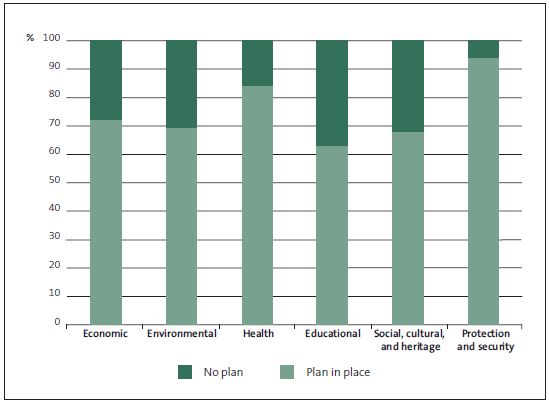
How well entities follow their planned approach
4.5
Based on the information we collected, maintenance and renewal plans are being followed for about 40% of assets, and those plans influenced the work carried out to some extent for a further 53% (see Figure 7). For the remaining assets, management did not follow their plans at all, or did not have a maintenance and renewal plan in place.
Figure 7
How well maintenance and renewal plans are followed
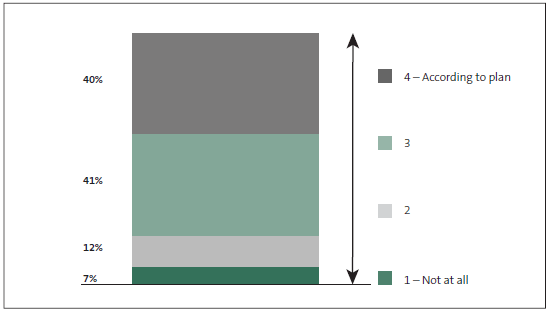
Note: Those following their plans to some extent are rated as grades 2 and 3.
4.6
Figure 8 shows how well each group follows their maintenance and renewal plans. The plans for social, cultural, and heritage assets and educational assets were the least likely to be followed as set out.
Figure 8
How well maintenance and renewal plans are followed, by service group
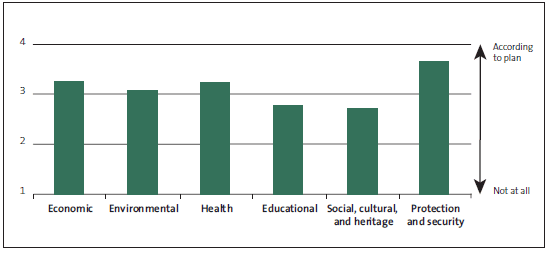
Note: These averages were calculated based on the responses on a scale of 1 to 4, with 1 specified as "Not at all" and 4 specified as "According to plan". Grades 2 and 3 were not specified.
Many public entities do not know the value of what has been deferred
4.7
We asked whether there was any deferred maintenance and renewals and, if so, to provide the estimated value. The information collected showed that nearly 45% of asset types have no deferred maintenance or renewals, suggesting that those public entities are managing their assets appropriately to meet service requirements. However, for about the same proportion of asset types, entities did not know the value of the deferred maintenance.
4.8
While we did not define deferred maintenance and renewals, we expect that entities would know if there had been deferrals, and the value, because they may affect the ability for assets to deliver services. The risks of deferrals cannot be managed if what has been deferred is unknown.
4.9
We compared the condition ratings of all assets. Figure 9 shows that assets for which there are deferred maintenance and renewals (both of known value and where there are deferrals but the value is unknown) have a lower condition rating than assets for which there are no deferrals.
Figure 9
The effect of deferrals on average condition
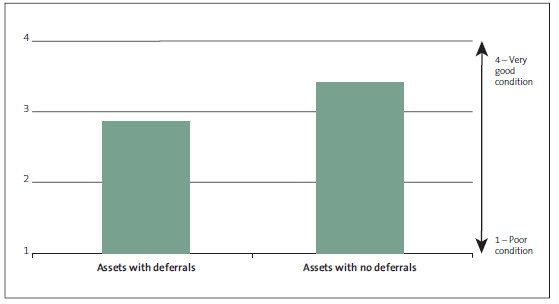
Note: Grade 1 was defined as “Poor condition” and grade 4 as “Very good condition”. Grades 2 and 3 were not defined
4.10
Figure 10 shows the percentage where entities did not know their deferrals by type of asset. Buildings and cultural assets11 are the asset types that are least likely to have a quantified deferrals balance. Most public entities have buildings and we expect that the value of deferrals should be known for this type of asset.
Figure 10
"Don't know" responses about deferred maintenance and renewals
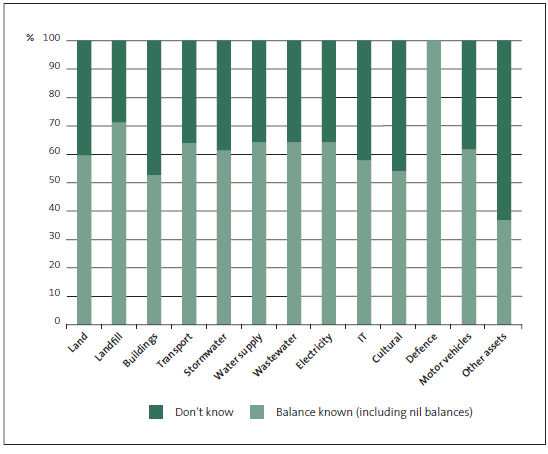
4.11
For those assets with deferrals, understanding the value of what has been deferred is important for assessing the risk of an effect on services. We were told that, for about 10% of asset types, entities knew the value of what was deferred. The service groups with most deferrals were educational and health.
4.12
Although the value of deferrals is less than 1% of the carrying value of the total assets, funding to reduce this amount could cause strains on budgets. We do not have enough information to understand over what period the value has been accumulated or whether this has affected services.
Learning example: Ruapehu District Council
4.13
Deferring expenditure has become a part of business for many entities, particular those feeling tight budgetary restraints. Local authorities in rural areas are regularly faced with tough decisions about maintaining networks of assets as populations decline. Not all assets for example, water supply assets can be easily relocated or used for a different purpose. When budget restraints are necessary, consideration is often given to deferring maintenance and renewals.
4.14
Ruapehu District has a large land area with a number of small asset networks that service rural townships. We set out as an example how Ruapehu District Council is looking at the challenge of maintaining these smaller networks and some of the work it is doing to address the consequences of its decisions.
| Understanding deferrals is important for planning |
|---|
|
Ruapehu is one of New Zealand's largest districts by area and has a small and dispersed population. The district covers 6700 square kilometres and has a usual resident population of only about 13,500. The environment is largely of high quality, with little heavy industry or dense residential developments. Although this makes the area an attractive tourist location, Ruapehu District Council faces the challenge of meeting current and future service expectations of residents and tourists within its ability to fund services affordably. Smaller townships in the district have water supply, stormwater, and wastewater systems that must be maintained to meet the needs of residents and also have the capacity to meet the high demand of peak tourist seasons. In these situations, asset failure could result in a significant health risk and an effect on the tourism reputation. Raetihi (population 1035 in 2006) is a small rural township servicing farming, market gardening, and forestry, located about 11 kilometres west of Ohakune. The wastewater network in Raetihi provides collection and treatment of the wastewater generated from connected properties. While the network consists of only 12.3 kilometres of main pipes, most of the network infrastructure was built between 1970 and 1979, and some was built before the 1950s. Underground assets present their own challenges in assessing condition, and obtaining reliable data is often costly. Without digging up these assets, there will always be an element of uncertainty, which can influence how well asset maintenance can be planned. Although asset management plans and infrastructure databases are in place and managed actively, "We only know what we know" and much of the previous information was unreliable. With a small population, sustainably funding the maintenance and renewal work required can be difficult. This forces the Council to prioritise and consider options carefully. It is also important to consider other factors, such as the potential effect of housing prices in Ohakune, which might force people to seek accommodation further afield. With Raetihi being less than 15 minutes' drive away, there is potential for increased peak demand and an effect on the services required in that area. Careful consideration of decisions is needed to address maintenance and renewals. Some solutions may have negative effects that mean they would be unsuitable. Downsizing pipes in some areas would be short-sighted, and onsite wastewater disposal could have wider effects on the soil and groundwater quality. The Council had focused on debt reduction by limiting capital spending with some positive results. However, deferred infrastructure expenditure was driving maintenance up and resulted in the network being overloaded, resulting in overflows at the wastewater pump stations and bottlenecks in parts of the network. In 2007, overflows were common and the Council was forced to act. Asset infrastructure renewal was essential in Raetihi, as the system was running near its maximum, verging on overflow for even medium rain events. The question is often not whether it is required, but where to start and how to pay for it. There are many options for infrastructure maintenance and upgrade, so involving wastewater operators was seen as key for the Council. In 2008, the worst places in the system where stormwater was entering the pipes and causing overflows were identified. Using closed-circuit television surveys and condition assessments of each of the mains allowed them to be ranked and an assessment to be made of what the best treatment was for each line. Using this information, the Council was able to prioritise works and their budgets. When resources are limited, it is important to consider the effect that decisions may have on rates today and in the future. Using technology meant a better understanding of what work was required and the effect of deferrals. Significant expenditure on some sections could be deferred by relining sections of pipe. For the Council, this proved to be a more cost-effective solution and allowed it to complete work on larger sections of the pipes. In towns like Raetihi, where the main sewer line averages 2.5 metres deep, the cost of digging up pipes increases significantly, and choosing an option to reline the pipes helped the Council to minimise the interruption to the community's services. After this work, infiltration and inflow no longer overwhelm the network. Medium rain no longer has a significant effect on the pump station, and being able to manage heavy rain reduces the need for reactive maintenance. It has now been two years since the wastewater pump station in Raetihi overflowed. In 2015, the Wastewater Treatment Plant resource consent will expire and upgrading will be required to meet regional requirements. For Ruapehu, this will require a significant upgrade. However, it is important to ensure that the network is as effective and efficient as it can be before considering the treatment requirements. To help with this process, the Council has changed how it assesses the condition of assets. Previously, the Council assessed condition every three years, taking a sample across the infrastructure. Now, by including these condition assessments in maintenance contracts, the Council knows that it is combining this with other data collection, such as closed-circuit television images, and will have better information to help form plans. Knowing what is deferred and the risk to services is important in making good decisions. Balancing funding with required work will always be challenging for organisations like the Council. The Council encourages others to ensure that they record deferrals clearly. Some lessons learned along the way are:
|
9 Educational assets do not include schools individually. Information for schools was collected as part of our audit of the Ministry of Education. This category also includes TEIs, Crown research institutes, and other central government entities responsible for co-ordination of the education sector.
10 In this paper, we use the term "plans" to describe the profiles of asset maintenance and renewals that we obtained information about.
11: This excludes other miscellaneous assets identified by auditors.
page top
